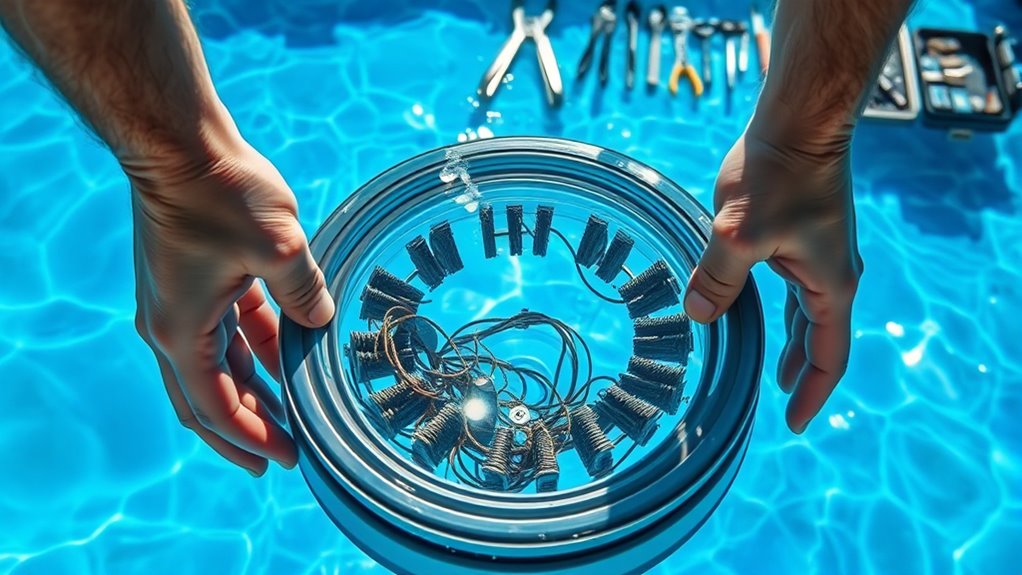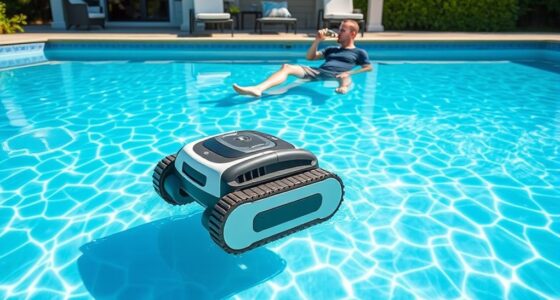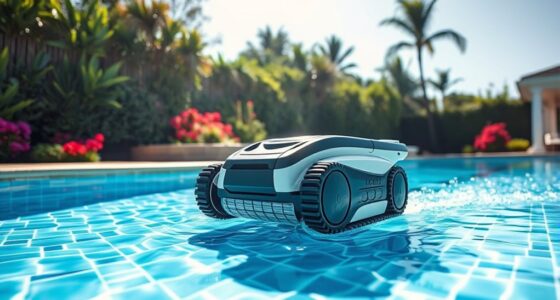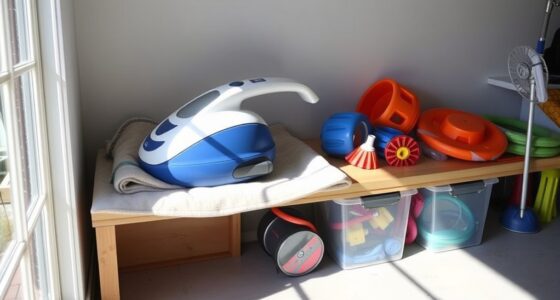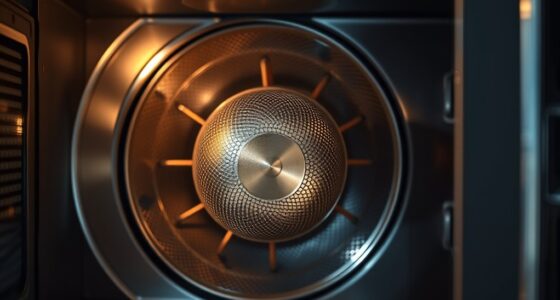To troubleshoot your automatic pool cleaner, start by inspecting for cracks, wear, or damage on parts like brushes, skirts, and hoses. Make sure filters and brushes are clean, and connections are tight to maintain proper suction. Check the wheels, tracks, and motor area for debris or obstructions that could cause sluggish movement or noise. Simple adjustments or replacements often fix common issues, and if you’re curious about detailed steps, a few more tips can help you keep it running smoothly.
Key Takeaways
- Inspect for physical damage, clogs, or wear on brushes, hoses, wheels, and connection points regularly.
- Ensure the power source and electrical components are functioning correctly and connections are secure.
- Check and clear hoses, filters, and skimmers of obstructions to maintain proper water flow and suction.
- Clean or replace worn brushes, skirts, and filters to improve debris pickup and cleaning efficiency.
- Schedule routine maintenance and consult professionals for complex repairs or persistent issues.
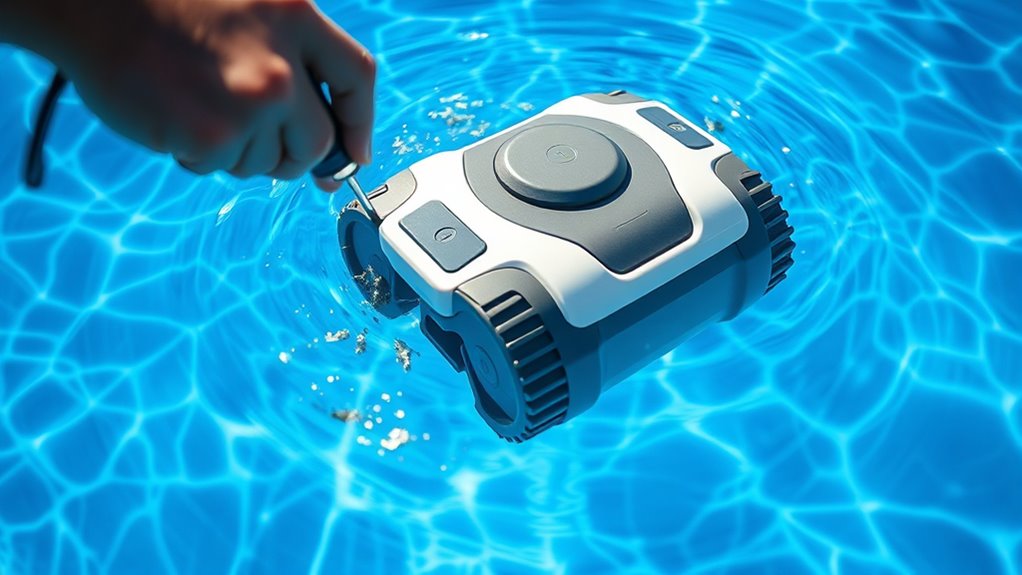
If your pool cleaner isn’t working as it should, troubleshooting can quickly get you back to a clean, sparkling pool. The first step is understanding that proper pool cleaner maintenance is essential for ideal performance. Over time, debris can clog hoses, brushes can wear out, and parts can become misaligned, all of which hinder cleaning efficiency. Begin by inspecting your automatic cleaner parts carefully; look for cracks, wear, or damage that might be impairing function. Regularly cleaning filters and brushes prevents buildup that can cause blockages or reduce suction power. Keep hoses free of kinks and obstructions, as these restrict water flow and diminish cleaning performance. If your automatic cleaner isn’t moving properly or seems sluggish, check the wheels or tracks to ensure they’re not stuck or damaged. Sometimes, debris caught in these moving parts can slow down the entire system. Additionally, ensuring that your pool cleaner’s power source is functioning correctly can prevent unexpected issues during operation. Next, examine the cleaner’s connection points to the pool’s skimmer or dedicated cleaner port. Loose or improperly fitted connections can lead to loss of suction, making the cleaner less effective or causing it to stop working altogether. Tighten fittings and replace worn or cracked hoses to restore proper airflow. If you notice that your cleaner isn’t picking up debris effectively, it might be time to replace some of the automatic cleaner parts, such as the brushes or the rubber skirts. Worn brushes can’t scrub surfaces properly, and damaged skirts can allow debris to escape, reducing overall cleaning efficiency. Also, check the filter or bag inside the cleaner; a full or clogged filter can considerably reduce suction, so empty or replace it regularly. Moreover, inspecting the automatic technology components can help identify issues that might be caused by outdated or malfunctioning parts, ensuring your cleaner stays in top condition. Keeping up with automation technology advancements can help you stay informed about new features that might improve your pool cleaning routine. If the cleaner is making strange noises or not moving at all, it might be due to motor issues or debris lodged in the drive system. Clearing out any debris from the motor area or drive wheels can often resolve these issues. Sometimes, replacing motor brushes or other electrical components is necessary if the motor has burned out or is failing. Remember, routine pool cleaner maintenance is key to catching these problems early; regular inspections can prevent minor issues from turning into costly repairs. Schedule regular inspections and cleanings to prevent minor issues from turning into costly repairs. Also, considering the component lifespan of parts can help in planning timely replacements before failure occurs. If you’re unsure about how to replace automatic cleaner parts or perform maintenance, consult the manufacturer’s instructions or contact a professional. Proper upkeep not only extends the lifespan of your pool cleaner but also ensures your pool stays pristine with minimal effort. Troubleshooting may seem intimidating at first, but with patience and attention to detail, you can quickly identify and fix most common problems.
Frequently Asked Questions
How Often Should I Replace My Pool Cleaner’S Parts?
You should follow a regular replacement schedule for your pool cleaner’s parts to guarantee ideal performance. Typically, you need to replace brushes and filters every few months, while hoses and wheels might last longer but should be checked monthly for wear. Part maintenance is essential; inspect your cleaner regularly and replace worn or damaged parts promptly. This proactive approach keeps your pool cleaner running smoothly and extends its lifespan.
Can I Use My Pool Cleaner in a Saltwater Pool?
They say, “Forewarned is forearmed,” and that’s true when considering saltwater compatibility for your pool cleaner. Yes, you can use your cleaner in a saltwater pool, but look for models designed for saltwater use. To prevent corrosion, guarantee proper corrosion prevention measures and rinse your cleaner thoroughly after each use. This way, you protect your investment while enjoying a sparkling, clean pool all season long.
What Is the Average Lifespan of an Automatic Pool Cleaner?
The average lifespan of an automatic pool cleaner typically ranges from 3 to 7 years, depending on usage and maintenance. To optimize its lifespan, you should perform regular pool cleaner maintenance, like cleaning brushes and filters, and store it properly when not in use. Proper care minimizes wear and tear, ensuring your pool cleaner stays effective longer and providing you with reliable cleaning performance over the years.
How Do I Prevent My Cleaner From Getting Stuck?
They say, “A stitch in time saves nine,” and that’s true for keeping your pool cleaner moving smoothly. To prevent your cleaner from getting stuck, regularly check for obstacles and perform obstacle removal before use. Clear debris from the pool and around the cleaner’s path. This proactive approach reduces the chances of entanglement, ensuring your cleaner runs efficiently and saves you time and frustration.
Is It Safe to Leave the Cleaner in the Pool Overnight?
You might wonder if it’s safe to leave your pool cleaner in overnight. Generally, it’s okay, but consider pool safety and overnight maintenance. Make sure the cleaner is in good condition and doesn’t pose a safety risk, like electrical hazards or clogging filters. Regularly check your pool and cleaner for issues. If you follow proper safety guidelines, leaving it overnight shouldn’t cause problems, and it can save you time during cleanup.
Conclusion
Now that you know how to troubleshoot your pool cleaner, you can identify issues quickly, fix problems efficiently, and keep your pool sparkling. By checking hoses, inspecting brushes, and cleaning filters regularly, you guarantee your cleaner works smoothly. Stay attentive, stay proactive, and stay confident in maintaining your pool’s cleanliness. With these simple steps, you’ll enjoy a trouble-free cleaning experience, a pristine pool, and more time relaxing in the water you love.
